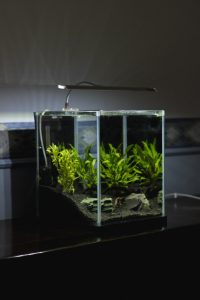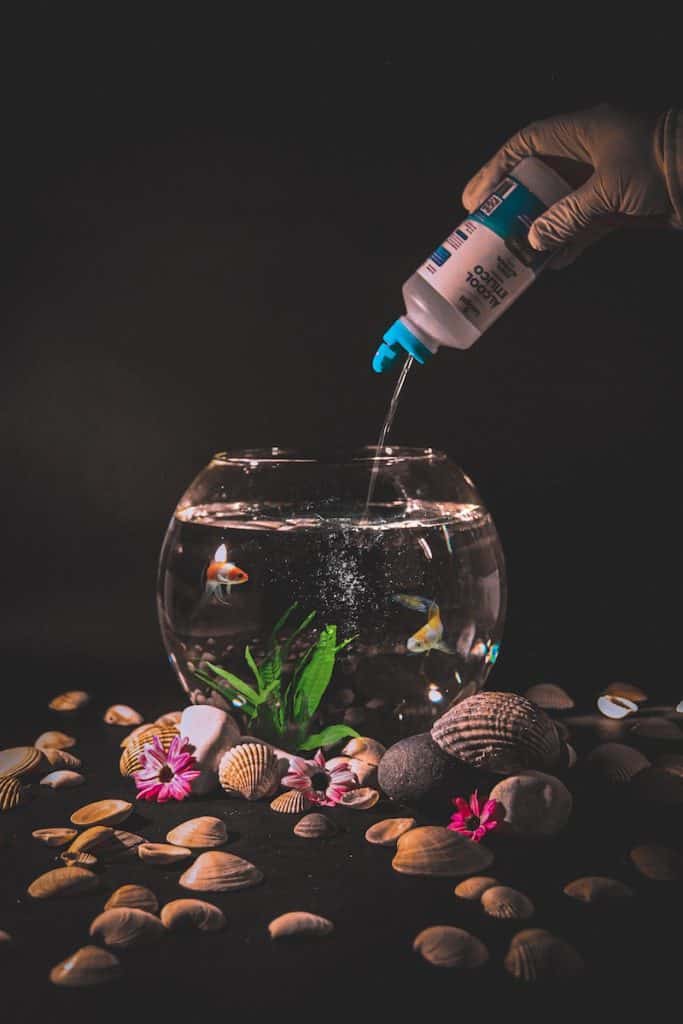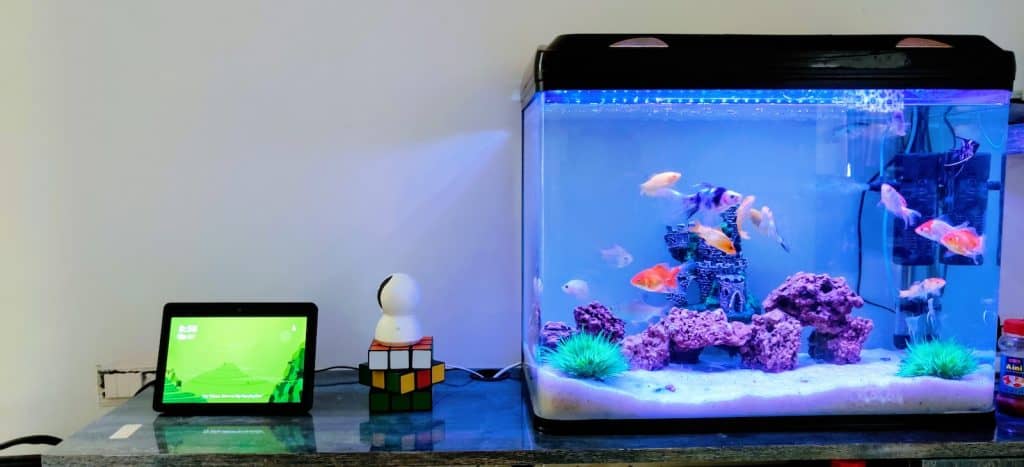When it comes to maintaining a healthy environment for your fish, nothing can be more vital than knowing how to clean a fish tank properly. Keeping fish as a pet can be a rewarding experience, but there are chores that come with it too, and cleaning their aquarium is an inevitable task. Doing so ensures not only a clear view of your aquatic friends but also helps keep your fish healthy, minimizing the risk of disease.
Fish tanks can become dirty over time, filling with algae, fish waste, leftover food, and other residues that can harm your freshwater aquarium’s inhabitants. Plus, a dirty tank is unsightly and detracts from the aesthetic pleasure an aquarium can provide. We’ll walk you through the necessary steps and supplies you’ll need to effectively clean your fish tank, including a gravel vacuum for the aquarium gravel, an algae pad for the glass, and properly treated water to replace the tank’s dirty water.
Remember, it’s vital to make sure the new tap water you add is of the same temperature as the existing tank water. Sudden changes can stress your fish and endanger their health. Also, using a water conditioner is a must as it helps remove harmful chlorine from the tap water. Consider visiting the local fish store to get your essential cleaning supplies – it’s your first step in ensuring your fish thrive in a clean and safe environment.
Understanding the Importance of a Clean Fish Tank

When learning how to clean a fish tank, it’s essential to understand why cleanliness is so crucial. Fish tanks, or freshwater aquariums, are closed systems that can easily become toxic without regular maintenance. They are not a pond with a continual inflow and outflow of water. Thus, you must take responsibility to ensure a healthy environment for your aquatic friends.
Fish waste, uneaten food, and decaying plant matter all contribute to the build-up of harmful substances in your tank. Ammonia levels can skyrocket, drastically lowering your water quality and causing health problems for the fish. Regular care and attention to your tank can maintain a clean, safe, and stress-free environment, keeping your fish healthy.
Water stability is another crucial aspect of fish tank maintenance. It’s crucial to keep the tank water at the same temperature as the original environment of your fish. Fluctuations in temperature can stress your fish and perhaps even lead to their early demise.
Also, note that algae can turn into a big problem if not addressed. Algae thrive in tanks with nutrient-rich water, and significant algae growth can eventually crowd out your artificial or live plants and deprive your fish of oxygen.
Equally important in the fish tank cleanliness spectrum is preserving beneficial bacteria. These bacterial colonies, nesting in areas like your aquarium gravel and filter media, help in breaking down organic waste. They act as a natural filtering mechanism, maintaining the balance of nitrate levels in your tank.
To maintain a clean fish tank, you’ll need some equipment like a gravel vacuum, an algae pad, or an algae scraper, a plastic razor blade for acrylic tanks or a razor blade for glass tanks, and sometimes chemical cleaning supplies specially designed for aquarium use. Remember always to hit up your local fish store for advice on the best tank cleaning tools to suit your specific aquarium needs!
Follow these pointers, clean your fish tank regularly, and your tank will stay in tip-top shape. Your fish will thank you with their vibrant colors and lively swimming! All of this is part of the fish tank step to maintaining the health and vitality of your aquatic buddies.
Recognizing the Signs of a Dirty Fish Tank

Keeping an eye on your fish tank’s health isn’t complicated, but you’ve got to know what you’re looking for. Here’s how to recognize when your fish tank needs a thorough cleaning.
First off, visibly dirty water can be a clear sign that it’s time to grab your cleaning supplies. If your aquarium water becomes cloudy or discolored, this typically indicates that there’s a high amount of fish waste, uneaten food, or algae floating around. All these can threaten the water quality, jeopardize the well-being of your fish, and make your fish tank appear uninviting.
Your fish’s behavior also tells you a story. Are they swimming less or hiding more? If your fish are acting out of the ordinary, they could be trying to signal that they’re living in unhealthy conditions. A healthy fish tank will keep your fish happy, healthy, and active.
Algae is a part of the natural ecosystem in a fish tank. However, significant algae growth on the tank’s inside glass, artificial plants, and other tank decorations is a sign that your tank needs to be cleaned. Regularly using an algae pad or an algae scraper will help keep the algae growth in check.
An unpleasant, rotting smell is another red flag that you shouldn’t ignore. While fish tanks generally have a distinctive smell due to the combination of tank water, fish, and live plants, any strong, offensive odors are typically a clear indication of a dirty fish tank.
The water’s temperature could also mean your tank requires a cleaning. If you are struggling to maintain the same temperature in your aquarium, there may be a buildup of waste generating extra heat, raising the water’s temperature more than is healthy for your fish.
Last but not least, try to spot any changes in your water’s ammonia levels. You can do this using an ammonia testing kit from your local fish store. High ammonia levels can turn your fish tank into not a pond but a hazardous environment for your beloved pets.
In between your regular, thorough cleans, consider making weekly partial water changes to maintain good water quality. Not only will this keep your fish healthy, but it will also make your ‘how to clean a fish tank’ journey a smoother ride. Remember, a clean fish tank is a happy fish tank!
Gathering Essential Fish Tank Cleaning Equipment

Before you delve into the process of how to clean a fish tank, it’s crucial to gather all the necessary equipment. Having these supplies on hand will streamline the cleaning process and make the task more efficient. From algae pads to gravel vacuums, here’s what you’ll need.
Your first step in preparation should be to purchase or locate an algae scraper or pad. Acquiring this crucial tool is fairly easy and can be found at your local fish store. You need this equipment to remove algae that can swiftly accumulate on the glass of your tank. Remember, only use tools specifically made for cleaning fish tanks. Regular scrub pads or tools may contain chemical residue that’s harmful for your little aquatic buddies. For acrylic tanks, go for an algae pad explicitly meant for acrylic aquariums. Using a regular algae scraper or a razor blade can cause unwanted scratches.
Next, grab a gravel vacuum. This tool is a lifesaver when it comes to sucking up fish waste, dead leaves, and uneaten food stuck in aquarium gravel. These waste materials can contaminate the tank water with harmful ammonia, leading to water quality problems. A gravel vacuum allows you to clean the gravel without extracting it from the tank, preserving beneficial bacterial colonies essential for maintaining water quality.
Additionally, you’ll need a bucket solely for aquarium use. This bucket should not be a shared tool. It’s reserved for cleaning your tank and nothing else to prevent contact with harmful household chemicals. Make sure that this bucket is large enough to hold up to 20-30% of your tank water. Weekly partial water changes are vital in maintaining a freshwater aquarium, and this bucket is just the right tool for that!
Lastly, an important item in your fish tank cleaning kit is a water conditioner. It neutralizes chlorine, chloramines, and other harmful substances present in tap water. So, when you’re adding fresh tap water into the tank, treat it with a suitable water conditioner first. This ensures it’s safe for your fish and does not interfere with beneficial bacteria in your tank.
In summary, properly cleaning your fish tank involves more than just scrubbing and water changing; proper equipment is crucial. A lack of the right tools can turn this task into a hassle and potentially threaten your fish’s health. Therefore, investing some time in gathering these essential fish tank cleaning supplies is worth the effort. Remember, a clean tank equals happy, healthy fish!
Step-by-Step Guide: How to Clean a Fish Tank
Getting how to clean a fish tank right is essential to keeping your fish healthy and happy. Regularly cleaning your aquarium is also crucial for maintaining a visually attractive environment.

1. Preparation: Start by turning off your aquarium’s heater and filter to prevent damage while you’re cleaning. Don’t do this abruptly; sudden changes can harm your fish.
2. Remove Algae: You’ll need an algae pad or an algae scraper for this task. Use it to gently clean the inside glass of your tank, carefully avoiding the silicon areas. Be diligent about this task. Algae growth, if left unchecked, can become a significant problem in fish tanks.
3. Clean the Decorations: Remove all tank decorations and give them a thorough clean. Using hot water (not soap or detergents), scrub away any algae or stubborn residue. Live plants should be gently washed under running water, while artificial plants can be cleaned more rigorously.
4. Vacuum the Gravel: With your decorations out of the way, it’s time to get a gravel vacuum and suction out fish waste and leftover food from your aquarium gravel. This not only keeps your tank looking clean but also maintains the quality of the tank water. Be careful to vacuum all areas of your tank, especially parts under decorations.
5. Partial Water Change: Water quality is critical for fish health. That’s why you should perform a weekly partial water change of about 10-15% of the tank’s dirty water. This process helps keep your ammonia levels balanced and the tank water fresh.
6. Clean the Filter: Don’t overlook the importance of clean filter media. Soak the filter pad in the old water you removed from the tank to get rid of trapped debris. Ensure to leave some residue on the filter pad as it contains beneficial bacteria that helps with water treatment.
7. Refill the Tank: Finally, refill your tank with tap water. But remember – water straight from the tap can contain harmful chemicals. Use a water conditioner or leave the water to stand for a few hours to remove the chlorine.
This guide should leave you with a clean fish tank and happy, healthy fish. Remember, it’s not a pond! Regular cleaning is necessary. And take it easy; your fish would prefer a slightly dirty tank over a completely destabilized environment caused by over-cleaning.
Not every local fish store will tell you this, but cleaning your fish tank is as much about maintaining water quality as it is about keeping the glass clean. Keep a close eye on it – you don’t want to find out that your tank needs cleaning because of a dead fish! Practice makes perfect when learning how to clean a fish tank, so don’t be discouraged if your first couple of tries don’t go perfectly. Your fish will thank you for your diligent effort!
Final Thoughts on Cleaning a Fish Tank
Keeping an aquarium clean is essential for the health and happiness of your fish. It involves more than just scrubbing the glass; it’s about maintaining water quality, controlling algae growth, and regulating temperature. Equipment such as a gravel vacuum, algae pad, water conditioner, and bucket dedicated solely to your aquarium are vital. Regular cleaning not only keeps your fish healthy but also enhances the aesthetic appeal of your tank. While the task may seem daunting at first, with knowledge, practice, and the right tools, cleaning a fish tank can be made much more manageable. Remember, a clean tank leads to happy, vibrant fish.
Other suggested articles:

